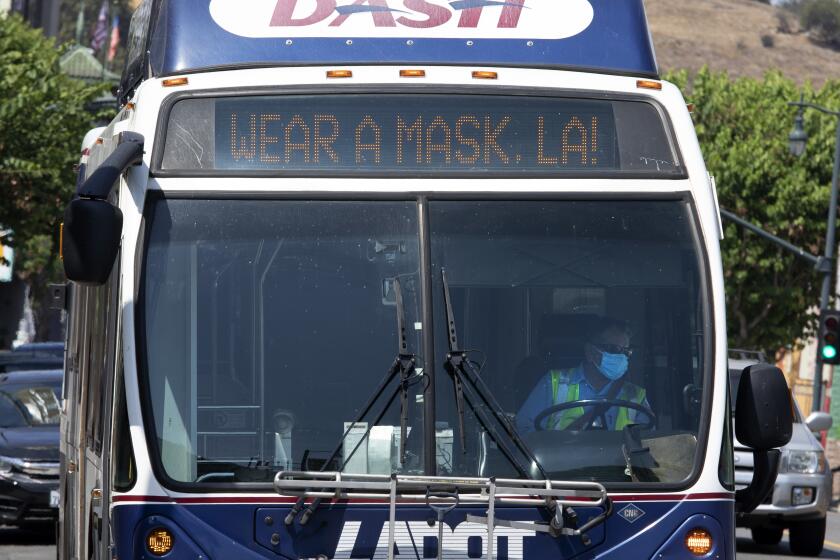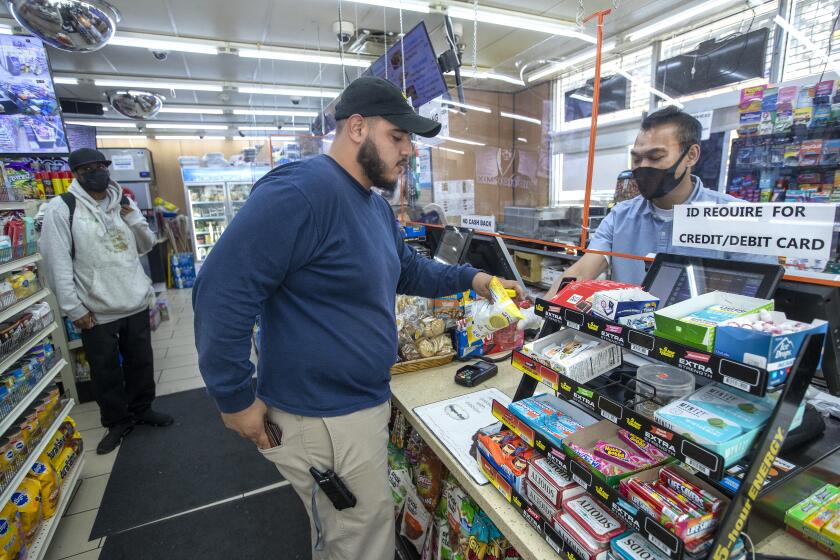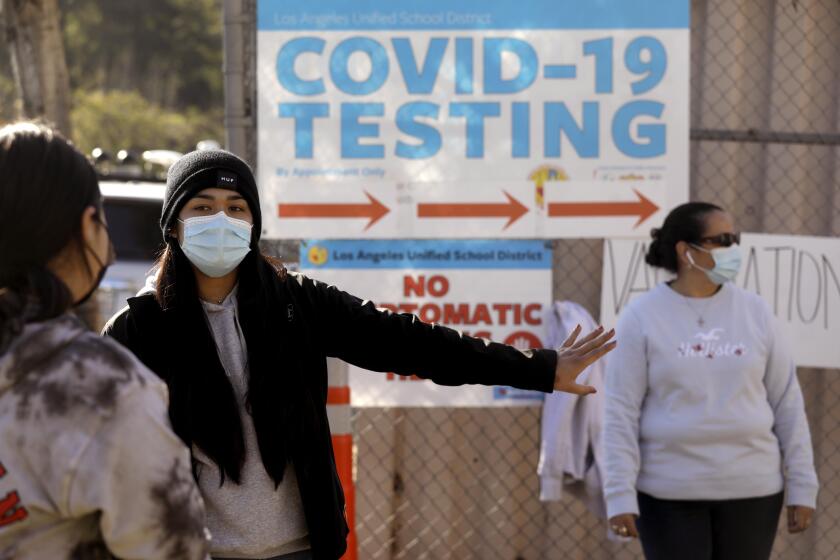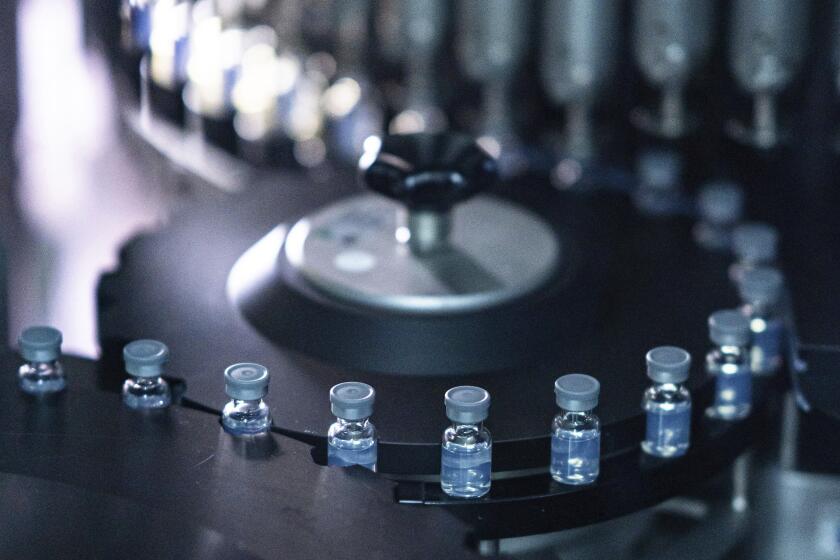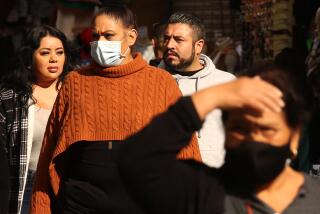L.A. County ends mask order on public transit, in airports

With the number of reported coronavirus cases and hospitalizations declining, health officials said the time has come to relax the order.
- Share via
Los Angeles County on Friday ended its local health order requiring masking while aboard public transit or inside transportation hubs, such as airports.
For months, L.A. has been the only California county to still mandate widespread masking in such settings — though some individual operators, most notably the San Francisco Bay Area Rapid Transit commuter rail system, also have such rules in place.
L.A. County health officials had previously cited the heightened risks of coronavirus spread and exposure for transit workers, but with a notable decline in reported cases and hospitalizations in recent weeks, health officials said the time has come to relax the order.
Masking is still strongly recommended in interior transit settings — and “from our perspective, [that] means it’s a great idea to keep your mask on,” L.A. County Public Health Director Barbara Ferrer said Thursday.
BART’s board of directors voted 8 to 1 on Thursday evening to effectively end the Bay Area rail system’s mask mandate next month. The resolution authorizes BART’s general manager to impose a new mandate if Alameda, Contra Costa, San Francisco, San Mateo or Santa Clara counties reinstate indoor masking, among other conditions.
“Because no such requirement now exists BART’s current mask requirement is set to end when it expires after Oct. 1,” BART officials said. “The first day masks will not be required will be Oct. 2.”
AC Transit, which operates bus service in the East Bay, also has a mask mandate in place.
L.A. County officials said they would reinstate a mask mandate on public transit and in transportation hubs should case rates rise again.
The Department of Public Health is moving toward ending its recommendation for universal masking in indoor public settings and businesses if coronavirus cases continue to fall.
L.A. County’s change coincides with the timing of the California Department of Public Health’s plan to lift state-ordered mandatory masking in jails and prisons, homeless shelters, and emergency and cooling centers in counties with a low COVID-19 community level, as defined by the U.S. Centers for Disease Control and Prevention.
Placement in that category — which includes most California counties — indicates the pandemic is not having a major impact on hospitals. The CDC updates its community level assessments, which indicates rates of new coronavirus-positive hospitalizations, every week, sorting counties into low, medium or high.
State masking orders would still apply in jails and prisons, shelters and cooling centers if there’s an outbreak, or if the facility is in a county with a medium or high COVID-19 community level.
As of Thursday, there were no California counties in the high level, and only eight in medium: Kern, Stanislaus, Merced, Butte, Tehama, Tuolumne, Glenn and Mariposa. About 95% of Californians live in counties with a low COVID-19 community level.
Masks are still required in healthcare facilities and long-term and senior care settings under a state health order. And the state is requiring that businesses and venues, including K-12 schools, “must allow any individual to wear a mask if they desire.”
The state is largely rescinding its broad recommendation that everyone — regardless of vaccination status — mask up in indoor public settings.
L.A. County also is easing its recommendation for universal masking in indoor settings, and instead says the practice should be a matter of personal preference in light of declining coronavirus case rates. The state is doing the same in counties where hospitalization levels are low.
“I’m hopeful that as we’ve reached this level where, in fact, we have less spread than we’ve seen for quite a while, people can feel comfortable making those decisions because there’s a lot less transmission,” Ferrer said.
County health officials would still strongly recommend certain individuals — including older or unvaccinated residents, as well as those with underlying health conditions or who live in high-poverty areas — to mask up in higher-risk settings. Such spaces include those that are crowded, involve close contact with others or have poor air flow.
Ferrer also urged people to wear masks on public transit and in hubs such as airports.
The L.A. County Department of Public Health had previously said it would ease its guidance whenever the county dipped below the threshold of 100 coronavirus cases a week for every 100,000 residents.
For the seven-day period that ended Thursday, L.A. County reported 98 coronavirus cases a week for every 100,000 residents.
Ferrer said a transit masking order would be reinstated if the case rate were to again surpass 100 and remain above that threshold for 14 straight days.
“You cannot just ignore the higher risk associated with public transit, especially for transit workers,” she said. “If case rates rise to indicate high transmission, layering in more protection to prevent spread is appropriate.”
California no longer requires coronavirus testing for unvaccinated workers at schools, healthcare facilities and other congregate settings.
Ferrer also spelled out the criteria that would trigger the return of a universal public indoor mask mandate — the likes of which hasn’t been in place since early March.
To get to that point, L.A. County would need to record significant coronavirus spread as well as see a dramatic worsening of new coronavirus-positive hospital admissions and a significant percentage of hospital beds being taken up by coronavirus-positive patients.
Conditions would have to deteriorate to a point seen only twice before in the pandemic — during the first fall-and-winter surge that began in late 2020, where morgues were so overwhelmed the National Guard was called in; and the first Omicron surge that struck after Thanksgiving 2021, which left emergency rooms inundated, ambulances facing delays at hospitals and patients’ scheduled surgeries canceled.
Specifically, L.A. County would need to hit two thresholds to return to a universal mask order, benchmarks that would be tougher to hit than the plan that had been in place this summer.
Assuming there’s an elevated coronavirus case rate, a universal mask mandate would return only if L.A. County saw at least 10 new coronavirus-positive hospital admissions a week for every 100,000 residents and had at least 10% of all staffed inpatient hospital beds occupied by coronavirus-positive patients.
Currently, the county is reporting 6.5 new coronavirus-positive hospital admissions per week for every 100,000 residents, and only 3.6% of hospital beds are occupied by such patients.
During the peak of this summer’s wave, when it appeared a renewed mask order was imminent, L.A. County topped out at 7.2% of hospital beds being taken up by coronavirus-positive patients, though it did temporarily exceed the other hospitalization metric.
“Everything we’re doing here is really about trying to move us to a place where we acknowledge how important it is to have new tools that help us keep each other safe. Those are vaccinations, boosters, testing and therapeutics,” Ferrer said. “But when we see things are getting out of hand, we need to go back to the strategies that worked before we had our vaccinations and boosters.”
Although a person’s schedule could change depending on health, occupation or travel plans, officials generally recommend the dose before holiday season.
Some L.A. County mask orders will remain in place beyond Friday, including the requirement that anyone exposed to the coronavirus wear a mask for 10 days following an exposure. Being exposed to the coronavirus is defined as sharing the same indoor air space for at least 15 minutes over a 24-hour period.
Infected individuals in L.A. County also are required to stay home for at least five days after their first symptoms or the date of their first positive test if they don’t have symptoms. They can exit isolation as early as the sixth day if they test negative on a rapid test, and generally can end isolation at the start of the 11th day without needing a negative test result.
L.A. County’s masking orders for exposed and infected people are the same as those imposed by the California Division of Occupational Safety and Health, or Cal/OSHA, for employees at a worksite. The California Department of Public Health has similar guidelines for exposed and infected people, but unlike L.A. County and Cal/OSHA, it makes them recommendations, not requirements.
California on Friday also is largely rescinding its strong recommendation that everyone — regardless of vaccination status — mask up when in indoor public settings and businesses. Instead, universal indoor masking is recommended only when a county’s COVID-19 community level is high.
The changes will give “Californians the information they should consider when deciding when to wear a mask, including the rate of spread in the community and personal risk,” Dr. Tomás Aragón, California’s public health director and state health officer, said in a statement.
California health officials say that mask use remains important for protection against infection. In 2021, consistently wearing a face mask in indoor public settings reduced the risk of getting a coronavirus infection, the state Department of Public Health said, citing a study it published. And a 10% increase in self-reported mask wearing tripled the likelihood of slowing community transmission of the coronavirus, officials said, citing a series of surveys nationwide.
Times staff writer Gregory Yee contributed to this report.
More to Read
Sign up for Essential California
The most important California stories and recommendations in your inbox every morning.
You may occasionally receive promotional content from the Los Angeles Times.
